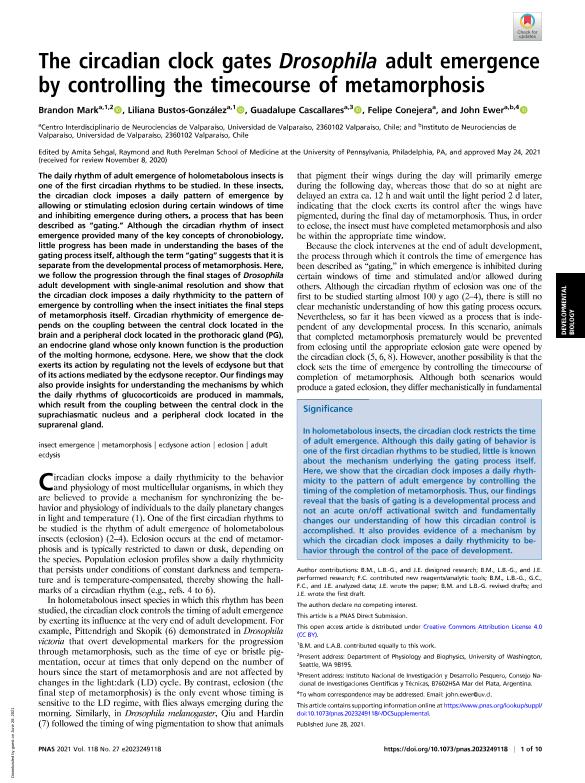Artículo
The circadian clock gates Drosophila adult emergence by controlling the timecourse of metamorphosis
Brandon, Mark Thomas; Bustos González, Liliana; Cascallares, Maria Guadalupe ; Conejera, Felipe; Ewer, John
; Conejera, Felipe; Ewer, John
 ; Conejera, Felipe; Ewer, John
; Conejera, Felipe; Ewer, John
Fecha de publicación:
07/2021
Editorial:
National Academy of Sciences
Revista:
Proceedings of the National Academy of Sciences of The United States of America
ISSN:
0027-8424
e-ISSN:
1091-6490
Idioma:
Inglés
Tipo de recurso:
Artículo publicado
Clasificación temática:
Resumen
The daily rhythm of adult emergence of holometabolous insects is one of the first circadian rhythms to be studied. In these insects, the circadian clock imposes a daily pattern of emergence by allowing or stimulating eclosion during certain windows of time and inhibiting emergence during others, a process that has been described as “gating.” Although the circadian rhythm of insect emergence provided many of the key concepts of chronobiology, little progress has been made in understanding the bases of the gating process itself, although the term “gating” suggests that it is separate from the developmental process of metamorphosis. Here, we follow the progression through the final stages of Drosophila adult development with single-animal resolution and show that the circadian clock imposes a daily rhythmicity to the pattern of emergence by controlling when the insect initiates the final steps of metamorphosis itself. Circadian rhythmicity of emergence depends on the coupling between the central clock located in the brain and a peripheral clock located in the prothoracic gland (PG), an endocrine gland whose only known function is the production of the molting hormone, ecdysone. Here, we show that the clock exerts its action by regulating not the levels of ecdysone but that of its actions mediated by the ecdysone receptor. Our findings may also provide insights for understanding the mechanisms by which the daily rhythms of glucocorticoids are produced in mammals, which result from the coupling between the central clock in the suprachiasmatic nucleus and a peripheral clock located in the suprarenal gland.
Palabras clave:
ADULT ECDYSIS
,
ECDYSONE ACTION
,
ECLOSION
,
INSECT EMERGENCE
,
METAMORPHOSIS
Archivos asociados
Licencia
Identificadores
Colecciones
Articulos(CCT - MAR DEL PLATA)
Articulos de CTRO.CIENTIFICO TECNOL.CONICET - MAR DEL PLATA
Articulos de CTRO.CIENTIFICO TECNOL.CONICET - MAR DEL PLATA
Articulos(IIMYC)
Articulos de INSTITUTO DE INVESTIGACIONES MARINAS Y COSTERAS
Articulos de INSTITUTO DE INVESTIGACIONES MARINAS Y COSTERAS
Citación
Brandon, Mark Thomas; Bustos González, Liliana; Cascallares, Maria Guadalupe; Conejera, Felipe; Ewer, John; The circadian clock gates Drosophila adult emergence by controlling the timecourse of metamorphosis; National Academy of Sciences; Proceedings of the National Academy of Sciences of The United States of America; 118; 27; 7-2021; 1-10
Compartir
Altmétricas



